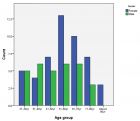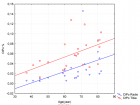Table of Contents
Short-term environmental impact of ambient air quality trends in during the COVID-19 pandemic in India
Published on: 17th December, 2021
OCLC Number/Unique Identifier: 9396212083
The lockdown, implemented in response to the COVID-19 epidemic, restricted the operation of various sectors in the country and its highlights a good environmental outcome. Thus, a comparison of air pollutants in India before and after the imposed lockdown indicated an overall improvement air quality across major Indian cities. This was established by utilizing the Central Pollution Control Board’s database of air quality monitoring station statistics, such as air quality patterns. During the COVID-19 epidemic, India’s pre-to-post nationwide lockdown was examined. The air quality data was collected from 30-12-2019 to 28-04-2020 and synthesized using 231 Automatic air quality monitoring stations in a major Indian metropolis. Specifically, air pollutant concentrations, temperature, and relative humidity variation during COVID-19 pandemic pre-to-post lockdown variation in India were monitored. As an outcome, several cities around the country have reported improved air quality. Generally, the air quality, on a categorical scale was found to be ‘Good’. However, a few cities from the North-eastern part of India were categorized as ‘Moderate/Satisfactory’. Overall, the particulate matters reduction was in around 60% and other gaseous pollutants was in 40% reduction was observed during the lockdown period. The results of this study include an analysis of air quality data derived from continuous air quality monitoring stations from the pre-lockdown to post-lockdown period. Air quality in India improved following the national lockdown, the interpretation of trends for PM 2.5, PM 10, SO2, NO2, and the Air Quality Index has been provided in studies for major cities across India, including Delhi, Gurugram, Noida, Mumbai, Kolkata, Bengaluru, Patna, and others.
Investigation of snow load reduction in the industrial sheds roof design with photovoltaic systems by mathematical modelling, solar system evaluation, X-steel simulation and thermodynamic practices
Published on: 8th September, 2021
OCLC Number/Unique Identifier: 9244772554
Since snow load is one of the loads of designing the industrial shed roof, this research presents a new system to reduce the industrial sheds roof design. In this system, sensitive units of moisture and temperature, which can be adjusted with different areas, are installed on the shed’s roof. The mechanism of system is that the sensors in the units detect the presence of snow on the shed roof and send an order to connect electricity to the elements; therefore, the snow on the roof melts by the heat generated. In this system, solar panels are used to supply electricity. As with the help of this mechanism, snow does not remain on the roof, it is possible to eliminate the snow load in the calculations of the shed and apply at least the live load of the sixth regulation (Due to having a one-story shed, minimum live load applied and it used only for the foundation design of the structure.), this issue will create an economic plan in shed designing. According to the study conducted in this research, it is shown that the dimensions of the sheet beam used in the shed are reduced, which will significantly reduce the cost of construction and installation to some extent. In the following, two samples of sheds with a span of 20 meters in the presence of snow and the absence of snow in the software were modelled, and the results were compared with each other.
Behavior evaluation of freundlich and langmuir isotherms in cadmium preconcentration using solid phase extraction method for linear and nonlinear numerical computational patterns
Published on: 8th September, 2021
OCLC Number/Unique Identifier: 9244773069
Cadmium is naturally present in the mineral cadmium sulfide which is a rare form of this element and the highest amount of cadmium is obtained from the extraction process of other minerals such as lead, copper and zinc. The release of this metal into the environment leads to widespread epidemiological effects. Therefore, measuring small amounts of this metal is also of particular importance. Small amount measuring methods of this metal are such as,preconcentration using solid phase extraction system using adsorbents. The main part of the preconcentration process is achieved by adsorption processes. In this study, the behavior of Freundlich and Langmuir adsorption isotherms for the capacity of TMON and IMNM adsorbents in cadmium adsorption has been evaluated by Power and Rational statistical distributions. At the end of the study, the constant coefficients of the Freundlich and Langmuir models were compared in both linear and non-linear modes. The results showed; the linearization method for the Kf coefficient of the Freundlich isotherm can cause errors equal to 41.6% in TMON adsorbent and 39.3% in IMNM adsorbent. Also, in parameter b, errors of 66.66% are obtained in TMON adsorbent and 32.45% in IMNM adsorbent.
Ranking of cadmium low amount measurement systems according to economic, environmental, and functional indicators using ELECTRE analytical method
Published on: 8th September, 2021
OCLC Number/Unique Identifier: 9244774024
Cadmium is one of the transition metals, known by the scientific name Cd. One of its main characteristics is the high toxicity, even in very little amounts. Cadmium is often released through industrial effluents, pesticides, chemical fertilizers, and the burning of fossil fuels. Since the presence of cadmium ions in the living organisms’ body, especially humans, can cause serious damage to the liver and pancreas, and also because its role in causing cancer has been proven, measuring very low amounts of this metal is of high importance. In the first step, this study has reviewed and analyzed common laboratory methods for measuring small amounts of cadmium. Then, according to economic, environmental, feasibility, speed, and accuracy factors, all available methods were evaluated using the ELECTRE technique. The results showed that the extraction methods using Dowex Optipore V-493 resin and extraction system in Triton X-114 surfactant, placed in the first and second positions.
Climate and garbage
Published on: 21st January, 2021
OCLC Number/Unique Identifier: 9031343389
Humanity has destroyed 70% of the land by arable land, reservoirs, asphalt, concrete, garbage and ore landfills.
Each of us sends 400-500 kg of garbage to the landfill per year. If from the garbage that the inhabitants of Russia throw out in a year, they built a tower with an area of one meter by one meter, then it would be possible to get to the Moon through it: https://greenpeace.ru/wp-content/uploads/2019/10/report-RUSSIA -GARBAGE.pdf
The area of the world’s landfill on land is the size of Mexico, and it is growing.

HSPI: We're glad you're here. Please click "create a new Query" if you are a new visitor to our website and need further information from us.
If you are already a member of our network and need to keep track of any developments regarding a question you have already submitted, click "take me to my Query."





















































































































































